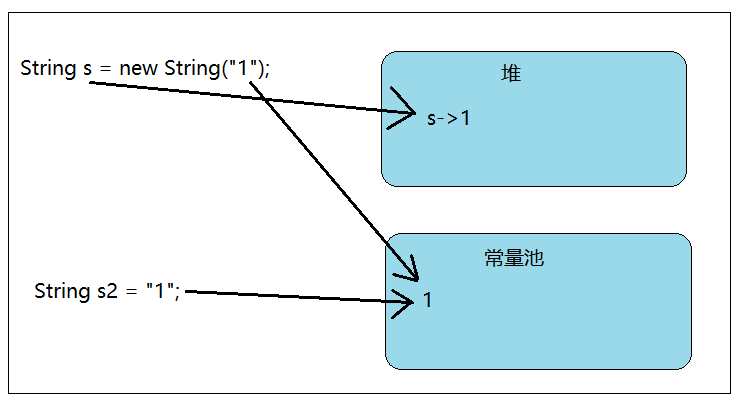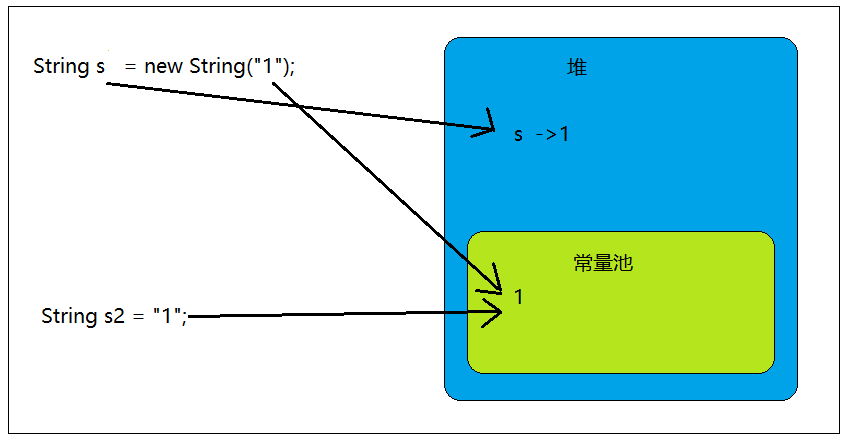一,前言
昨天简单整理了JVM内存分配和String类常用方法,遇到了String中的intern()方法。本来想一并总结起来,但是intern方法还涉及到JDK版本的问题,内容也相对较多,所以今天就弥补昨天缺失的知识点。
二,String.intern()
先来看下网上流行的关于intern()方法的示例代码:
public static void main(String[] args) {
String s = new String("1");
s.intern();
String s2 = "1";
System.out.println(s == s2);
String s3 = new String("1") + new String("1");
s3.intern();
String s4 = "11";
System.out.println(s3 == s4);
}
打印结果是:
JDK6:false,false
JDK7:false,true
首先我们先来回顾一个概念:
- jdk6及以前中常量池是存放在方法区中。
- jdk7常量池移动到堆中。
为什么要移动?常量池主要是存储加载类的信息,编译器生成的字面量和符号引用等。它的大小大约只有4M,如果大量使用intern()方法,便会造成常量池内除溢出的情况,同时GC回收也有一定的困难度。而且在jdk8以后,连Perm区域都没有了,被替换成了元区域。
接着我们再来说说上面两种情况不同的结果。
JDK6:
String s = new String("1");
1,这句代码实际上是生成两个实例对象,先在常量池中声明为1的字符对象,再通过关键字new生成1的字符对象并被s引用。
2,接着 s.intern();先在常量池中查找是否有相应的字符串存在,如果有,直接返回引用,否则,在常量池中生成相应的字符串并返回引用。
3,而String s2 = "1";是属于符号引用,直接在常量池中生成。
4,最后判断s 是否与s2相等,通过上面的分析,s指向的是通过关键字new出来的在堆中的字符对象,而s2是符号引用的在常量池中的字符对象,所以返回的结果为false。如下图所示:

String s3 = new String("1") + new String("1");同理这句代码实际上也是产生2个字符对象,其原理和上面分析是一样的,而最后判断s3与s4的值,结果还是一个堆中的s3与常量池中的s4比较,那返回的结果必然是false。
JDK7:
String s1 = new String("1");
s1.intern();
String s2 = "1";
System.out.println(s == s2);
1,这一部分代码与jdk6中的分析是类似的,但唯一不同的是s1.intern();返回的是在常量池中的引用,并不会在常量池中复制一份再返回引用。
String s2 = "1";与s1.intern();指向的是同一个引用。

2,最后比较s与s2的值,s是堆中,s2是常量池中,因而返回结果为false。
3,接着我们再来看下面一段代码:
String s3 = new String("1") + new String("1");
s3.intern();
String s4 = "11";
System.out.println(s3 == s4);
我们先来分析第一句代码,同样是生成两个字符对象,先在常量池中生成为1的字符对象,再在堆中生成s3为11的字符对象。接着s3.intern();执行便去常量池中查询是否存在为11的字符对象,但是发现没有。这个时候在jdk7中便不会再复制一份为11到常量池中,而是直接返回堆中11的字符对象的引用。所以它与s3的引用地址是相同的。
String s4 = "11";这句代码是符号引用,直接去常量池中创建,但是发现池中已经存在为11的字符对象的引用,因此直接返回该引用。最后判断s3与s4是否相等,因为它们之间的引用的相同的,所以返回的结果为true。如下图所示:

三,补充内容
本以为写到这里就结束了,没想到一位评论者告诉我在jdk8中,对于intern方法的处理与jdk7是不一样的。在这里非常感谢,是我的疏忽。
下面请看jdk8中关于intern方法的源码解释:
/**
* Returns a canonical representation for the string object.
* <p>
* A pool of strings, initially empty, is maintained privately by the
* class {@code String}.
* <p>
* When the intern method is invoked, if the pool already contains a
* string equal to this {@code String} object as determined by
* the {@link #equals(Object)} method, then the string from the pool is
* returned. Otherwise, this {@code String} object is added to the
* pool and a reference to this {@code String} object is returned.
* <p>
* It follows that for any two strings {@code s} and {@code t},
* {@code s.intern() == t.intern()} is {@code true}
* if and only if {@code s.equals(t)} is {@code true}.
* <p>
* All literal strings and string-valued constant expressions are
* interned. String literals are defined in section 3.10.5 of the
* <cite>The Java™ Language Specification</cite>.
*
* @return a string that has the same contents as this string, but is
* guaranteed to be from a pool of unique strings.
*/
大致解释一下就是说,当调用intern()方法时,如果池已经包含string这个对象时,由equals(Object)方法去比较,则池中的字符串为返回。否则,将此String对象添加到池和对这个String对象的引用被返回。
四,总结
1,对于常量池的概念要注意jdk6与jdk7之间的变化。
2,intern()方法在不同jdk版本之间的变化,jdk7中如果常量池中不存在,不会再复制一份到常量池中,而是返回堆中的存在的引用地址。
3,jdk6常量池在方法区中,jdk7常量池在堆中,jdk8取消方法区,替换成元区域。
最后关于String类中intern方法就介绍这里,其实从实际开发工作中,我们只需要了解jdk7及以后版本的原理就可以了,毕竟现在市面上很少再用jdk6版本。但是这里总结出来也是为了更方便的参照理解,同时也涉及到一些关于JVM内存的相关知识,本篇博客是接着上一篇内容的缺失的知识点。
以上内容均是自主学习总结的,如有不适之处还请留言(邮箱)指教。
感谢阅读!